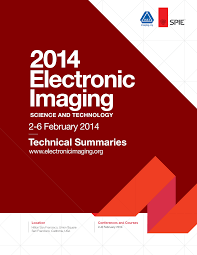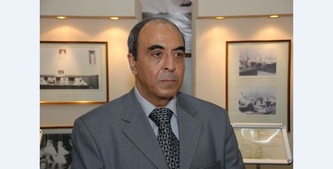Consultant expert, Dr. Mohamed Taha Electronic Imaging IS&T/SPIE Conferences and Courses Technical Summaries Location
Consultant expert, Dr. Mohamed Taha
Electronic
Imaging
IS&T/SPIE
Conferences and Courses
Technical Summaries
Location
Hilton San Francisco, Union Square
San Francisco, California, USA
Electronic
Imaging
2014
Electronic
Imaging
Click on the Conference
Title to be sent to that page
SPIE is the international society for optics and photonics, a not-for-profit organiza-
tion founded in 1955 to advanced light-based technologies. The Society serves nearly
225,000 constituents from approximately 150 countries, offering conferences, continu-
ing education, books, journals, and a digital library in support of interdisciplinary infor-
mation exchange, professional growth, and patent precedent. SPIE provided over $3.3
million in support of education and outreach programs in 2012.
Contents
9011: Stereoscopic Displays and Applications XXV 3
9012: The Engineering Reality of Virtual Reality 2014 40
9013: 3D Image Processing, Measurement (3DIPM),
and Applications 2014 50
9014: Human Vision and Electronic Imaging XIX 62
9015: Color Imaging XIX: Displaying, Processing,
Hardcopy, and Applications 87
9016: Image Quality and System Performance XI 100
9017: Visualization and Data Analysis 2014 117
9018: Measuring, Modeling, and Reproducing Material
Appearance 126
9019: Image Processing: Algorithms and Systems XII 139
9020: Computational Imaging XII 150
9021: Document Recognition and Retrieval XXI 165
9022: Image Sensors and Imaging Systems 2014 171
9023: Digital Photography X 183
9024: Image Processing: Machine Vision
Applications VII 199
2025: Intelligent Robots and Computer Vision XXXI:
Algorithms and Techniques 213
9026: Video Surveillance and Transportation Imaging
Applications 2014 227
9027: Imaging and Multimedia Analytics in a Web and
Mobile World 2014 252
9028: Media Watermarking, Security, and
Forensics 2014 261
9029: Visual Information Processing and
Communication V 271
9030: Mobile Devices and Multimedia:
Enabling Technologies, Algorithms, and
Applications 2014 279
2014 Symposium Chair
2014 Symposium Co-chair
Sergio R Goma
Qualcomm Inc.
Sheila S Hemami
Northeastern University
2014 Short Course Chair
Choon-Woo Kim
Inha University
2014 Short Course Co-chair
Majid Rabbani
Eastman Kodak Co.
Electronic
Imaging
IS&T/SPIE
Stereoscopic Displays and Applications XXV
Monday - Wednesday 3 –5 February 2014
Part of Proceedings of SPIE Vol. 9011 Stereoscopic Displays and Applications XXV
9011-1, Session 1
Stereoscopic cell visualization: from
mesoscopic to molecular scale
Björn Sommer, Christian Bender, Tobias Hoppe, Chrstian
Gamroth, Lukas Jelonek, Univ. Bielefeld (Germany)
CONTEXT
Stereoscopic vision is a substantial aspect of three-dimensional
visualization approaches. Although most recent animation movies
created for cinemas are shown in stereoscopic 3D (S3D), there are
still many areas which do not take advantage of this technology. One
of these areas is cell visualization. Despite the fact that many protein
crystallographers have preferred working with stereoscopic devices for
over a decade, it is quite astonishing that cell visualization seems to have
ignored S3D completely, even though stereoscopic visualization of the
cellular cosmos not accessible to the human eye bears high potential.
Furthermore, the scientific community often works with interactive
visualization environments. These tools usually provide S3D for different
hardware configurations, but the intensity of the stereoscopic effect can
only be manually adjusted by using slider buttons. This technique is
sufficient to explore a single instance of a molecule, but it is inconvenient
when navigating through a large environment on multiple scales.
OBJECTIVE
In this work approaches will be discussed to apply S3D to 1) rendered
cell animations and 2) interactive cell environments by using freely
available open source tools.
A very important aspect in cell visualization is the bridging of scales. The
mesoscopic level starts at a few thousands of nanometers – related to
the cell and its components – whereas the molecular level goes down to
a few Angstrom, where single atoms are visible. Therefore, both scales
may differ by a factor of 100,000. This is especially a problem if the
stereoscopic effect should be adjusted during an interactive navigation
process.
METHOD
For the rendered animations it will be shown how to use Blender
in combination with Schneider’s Stereoscopic Camera plug-in. An
exemplary short movie was created, starting in the blood vessels,
proceeding with the inner cell components and finally showing the
translation and transcription process based on protein/PDB models.
The interactive exploration environments are provided by the
CELLmicrocosmos project. On the molecul
الخبير الاستشاري الدكتور محمد طه
إلكتروني
التصوير
IS & T / SPIE
المؤتمرات والدورات
الملخصات الفنية
موقع
هيلتون سان فرانسيسكو ، يونيون سكوير
سان فرانسيسكو ، كاليفورنيا ، الولايات المتحدة الأمريكية
إلكتروني
التصوير
2014
إلكتروني
التصوير
انقر فوق المؤتمر
سيتم إرسال العنوان إلى تلك الصفحة
SPIE هي الجمعية الدولية للبصريات والضوئيات ، وهي منظمة غير ربحية-
تأسست في عام 1955 لتقنيات متقدمة تعتمد على الضوء. يخدم المجتمع تقريبا
225000 عضو من حوالي 150 دولة ، يقدمون مؤتمرات ، استمرار-
التعليم والكتب والمجلات والمكتبة الرقمية لدعم المعلومات متعددة التخصصات-
التبادل التعاوني والنمو المهني وسابقة براءات الاختراع. قدمت SPIE أكثر من 3.3 دولار
مليون دولار لدعم برامج التعليم والتوعية في عام 2012.
محتويات
9011: العروض المجسمة والتطبيقات الخامس والعشرون 3
9012: الواقع الهندسي للواقع الافتراضي 201440
9013: معالجة الصور ثلاثية الأبعاد والقياس (3DIPM) ،
والتطبيقات 201450
9014: الرؤية البشرية والتصوير الإلكتروني XIX 62
9015: التصوير الملون التاسع عشر: العرض ، المعالجة ،
النسخة الورقية والتطبيقات 87
9016: جودة الصورة وأداء النظام XI 100
9017: التصور وتحليل البيانات 2014117
9018: قياس ونمذجة وإعادة إنتاج المواد
المظهر 126
9019: معالجة الصور: الخوارزميات والأنظمة XII 139
9020: التصوير الحاسوبي XII 150
9021: التعرف على المستندات واسترجاعها XXI 165
9022: مجسات الصور وأنظمة التصوير 2014171
9023: التصوير الرقمي X 183
9024: معالجة الصور: رؤية الآلة
التطبيقات السابع 199
2025: الروبوتات الذكية والرؤية الحاسوبية الحادي والثلاثون:
الخوارزميات والتقنيات 213
9026: المراقبة بالفيديو وتصوير النقل
تطبيقات 2014227
9027: تحليلات التصوير والوسائط المتعددة في الويب و
موبايل وورلد 2014252
9028: الوسائط المائية ، الأمن ، و
الطب الشرعي 2014261
9029: معالجة المعلومات المرئية و
التواصل 271
9030: الأجهزة المحمولة والوسائط المتعددة:
تمكين التقنيات والخوارزميات و
تطبيقات 2014279
2014 كرسي الندوة
2014 الرئيس المشارك لندوة
سيرجيو آر جوما
شركة كوالكوم
شيلا س همامي
جامعة نورث إيسترن
2014 كرسي الدورة القصيرة
تشون وو كيم
جامعة اينها
2014 الرئيس المشارك للدورة القصيرة
ماجد رباني
شركة ايستمان كوداك
إلكتروني
التصوير
IS & T / SPIE
العروض والتطبيقات المجسمة الخامس والعشرون
الإثنين - الأربعاء 3 - 5 فبراير 2014
جزء من وقائع مجلد SPIE. العروض والتطبيقات المجسمة 9011 XXV
9011-1 ، الجلسة 1
تصور الخلية المجسمة: from
الميزوسكوبي إلى النطاق الجزيئي
بيورن سومر ، كريستيان بندر ، توبياس هوبي ، كريستيان
جامروث ، لوكاس جيلونيك ، جامعة. بيليفيلد (ألمانيا)
سياق
تعتبر الرؤية المجسمة جانبًا أساسيًا من الجوانب ثلاثية الأبعاد
نهج التصور. بالرغم من أن أحدث أفلام الرسوم المتحركة
تم إنشاؤها لدور السينما معروضة في صورة مجسمة ثلاثية الأبعاد (S3D) ، هناك
لا تزال العديد من المجالات التي لا تستفيد من هذه التكنولوجيا. واحد
من هذه المناطق هو تصور الخلية. على الرغم من حقيقة أن الكثير من البروتين
فضل علماء البلورات العمل مع الأجهزة المجسمة لـ
على مدار عقد من الزمان ، كان من المدهش حقًا أن يكون التصور الخلوي موجودًا
تجاهل S3D تمامًا ، على الرغم من التصور المجسم لـ
الكون الخلوي الذي لا يمكن للعين البشرية الوصول إليه يحمل إمكانات عالية.
علاوة على ذلك ، غالبًا ما يعمل المجتمع العلمي بشكل تفاعلي
بيئات التصور. توفر هذه الأدوات عادةً S3D لمختلف
تكوينات الأجهزة ، ولكن شدة تأثير مجسمة يمكن
يتم ضبطه يدويًا فقط باستخدام أزرار شريط التمرير. هذه التقنية
يكفي لاستكشاف مثيل واحد للجزيء ، ولكنه غير ملائم
عند التنقل عبر بيئة كبيرة على مستويات متعددة.
موضوعي
في هذا العمل ستتم مناقشة مناهج تطبيق S3D على 1) المقدمة
الرسوم المتحركة الخلوية و 2) بيئات الخلية التفاعلية باستخدام بحرية
أدوات مفتوحة المصدر متاحة.
يعتبر سد المقاييس جانبًا مهمًا جدًا في تصور الخلية. ال
يبدأ مستوى mesoscopic من بضعة آلاف من النانومترات - المرتبطة بـ
الخلية ومكوناتها - بينما ينخفض المستوى الجزيئي إلى
عدد قليل من أنجستروم ، حيث تكون الذرات المفردة مرئية. لذلك ، كلا المقياسين
قد تختلف بمعامل 100.000. هذه مشكلة خاصة إذا كان
يجب ضبط التأثير المجسم أثناء التنقل التفاعلي
عملية.
طريقة
بالنسبة للرسوم المتحركة المقدمة ، سيتم توضيح كيفية استخدام Blender
بالاشتراك مع المكون الإضافي للكاميرا المجسمة من شنايدر. ان
تم إنشاء فيلم قصير نموذجي ، بدءًا من الأوعية الدموية ،
المضي قدما في مكونات الخلية الداخلية وأخيرا إظهار
عملية الترجمة والنسخ على أساس نماذج البروتين / PDB.
يتم توفير بيئات الاستكشاف التفاعلية بواسطة
مشروع CELLmicrocosmos. على الجزيء




